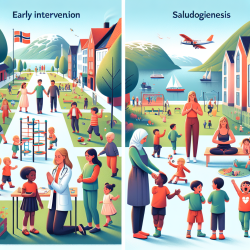Introduction
In the realm of speech-language pathology, the well-being of children is of utmost importance. Understanding the factors that influence their health outcomes can guide practitioners in creating effective interventions. A recent study titled Fear of Neighborhood Violence During Adolescence Predicts Development of Obesity a Decade Later: Gender Differences Among African Americans sheds light on the significant impact of neighborhood violence on obesity among African American youth. This blog explores the findings and implications of this research, offering insights for practitioners seeking to enhance their skills and contribute to better outcomes for children.
Understanding the Research
The study conducted by Assari et al. (2016) focused on the relationship between fear of neighborhood violence during adolescence and the development of obesity in African American youth. The researchers utilized an 18-year longitudinal dataset, examining the trajectories of body mass index (BMI) from ages 21 to 32. The study revealed a compelling gender difference: fear of neighborhood violence at age 15 was predictive of an increase in BMI for African American females, but not for males.
This finding underscores the importance of addressing fear and anxiety in disadvantaged neighborhoods, particularly for young females. The study suggests that perceived fear of violence can lead to reduced physical activity and increased stress-related behaviors, contributing to obesity over time.
Implications for Practitioners
As practitioners, understanding the broader social determinants of health is crucial in developing comprehensive interventions. Here are some actionable steps based on the study's findings:
- Promote Safe Environments: Collaborate with community leaders and policymakers to advocate for safer neighborhoods. Initiatives such as improved street lighting, community policing, and neighborhood watch programs can enhance the sense of safety.
- Encourage Physical Activity: Design programs that encourage physical activity in safe spaces. This could include organized sports, dance classes, or walking groups in secure areas.
- Address Mental Health: Provide resources and support for mental health services that address fear and anxiety related to neighborhood violence. Counseling and support groups can be beneficial.
- Engage Families: Work with families to create supportive home environments that encourage healthy behaviors and open communication about fears and concerns.
Encouraging Further Research
The study highlights the need for further research to explore the mechanisms linking fear of violence to obesity. Practitioners can contribute to this field by conducting community-based research, collecting data on neighborhood safety perceptions, and evaluating the effectiveness of interventions. Collaborative efforts with researchers can lead to more targeted and effective strategies for addressing obesity in African American youth.
Conclusion
The study by Assari et al. (2016) provides valuable insights into the impact of neighborhood violence on obesity among African American females. By understanding these dynamics, practitioners can develop interventions that not only address speech and language needs but also contribute to the overall health and well-being of children. Together, we can create safer environments and healthier futures for all children.
To read the original research paper, please follow this link: Fear of Neighborhood Violence During Adolescence Predicts Development of Obesity a Decade Later: Gender Differences Among African Americans.










